Saturday, May 4th - Tuesday, May 7th

Typical street scene. Beautiful wisteria.

Cars are always parked like this along the canal across the narrow street from their homes. They surely must have to get out on the passenger side and a lot of their cars are very small and standard transmission. Must be very awkward.
Sunday we visited the Vermeer Center where they explained the history of Johannes Vermeer and his paintings. The building was the site of the former St. Lucas Guild where he was Dean of the painters. He was one of the Dutch Masters and known as the Master of Light. He painted mostly domestic interior scenes.
This church actually had an orange path to follow and lots of signs explaining everything you were looking at. Almost every deceased member of the royal family since William of Orange has been interred here in royal crypts.
Beestenhof Square below is where they used to bring their livestock to market to be auctioned off. We stopped at a restaurant here for a beer and iced tea and a little people watching around the square on our last night here. Then we headed home to pack up for our last move.
Saturday we left our apartment at 10:00 AM and went to Midi-Zuid (south) Station where we caught the Eurostar train to Rotterdam. There we switched trains to get to Delft.
This is the new Delft Train Station that opened in 2015 between The Hague and Rotterdam, the oldest railway in the country. The original station opened in 1847. The huge, wavy, vaulted ceiling is 7,700 square meters of aluminum beams with an enormous 1877 historic map of Delft and its surroundings printed on it. The walls and columns are adorned with the famous Delft blue tiles. 300 to 350 trains pass through here daily.
We walked about six blocks to our next apartment which was on the third floor above a bakery. Very convenient for breakfasts. The Saturday street market was going on right in front of out apartment, so we picked up some fresh bread, cheese, and blueberries to snack on, and some packaged stoopwaffels to bring home for the grandkids. This is the view from our little bedroom in the apartment which we shared with the two young men from India who lived there. They were very gracious hosts and we had several nice visits with them when our schedules crossed paths. They both came to Delft to go to the world renowned Delft University of Technology. They are both engineers and one is working with a team that is developing a substance that will be used on the outside of returning space modules, so they do not burn up upon re-entry and can be used again.
We walked over to the Markt (Market Square) which was about two blocks from our apartment. Above is the Neiuw Kerk (new church) on one end of the square,
facing the Town Hall on the opposite end with lots of restaurants and shops in between.
We ate lunch here at the Flying Fox Inn where the famous painter, Johannes Vermeer, was born. The sign on the front said "food, drinks and lodging since 1632". I had bouillabaisse and a slice of brown bread, both of which were absolutely delicious! John had an omelet, salad and a bier, which he said was also very good.

Typical street scene. Beautiful wisteria.

Cars are always parked like this along the canal across the narrow street from their homes. They surely must have to get out on the passenger side and a lot of their cars are very small and standard transmission. Must be very awkward.
Sunday we visited the Vermeer Center where they explained the history of Johannes Vermeer and his paintings. The building was the site of the former St. Lucas Guild where he was Dean of the painters. He was one of the Dutch Masters and known as the Master of Light. He painted mostly domestic interior scenes.
We then walked around town a bit and passed the Oude Kerk (old church).
Across the street from the church was this late-Gothic private home with stone facade and nice turret built about 1505. Since 1645 it has been the seat of the Dijk Conservancy Board and has the colorful coats-of-arms of various 17th century water authority directors decorating the outside of the building. Any positions having to do with the dikes and canals were very important positions. They control the dredging and the level of the canals within the town and the surrounding polders (farm land). There is a yardstick on the wall of the canal that marks the NAD (normal Amsterdam point). That is average sea level in Amsterdam and the polders are three yards below that point. On the sidewalks we are standing above sea level and the canals are below sea level.
Also across the street from the church is the Museum Prinsenhof in what was originally St. Agatha's Church/Convent/Monastery built in the Middles Ages. Above is the old monastic herb garden in the rear. It was later the residence of Prince William of Orange leader of the revolt against the Spanish Hapsburg rule starting the Eighty Years' War (1568 to 1648). Prinsenhof literally means court of the prince or prince's house. His properties were confiscated by the King of Spain and he was forced to live here from 1572 to 1584 when he was assassinated because the King of Spain declared him an outlaw and offered a reward of 25,000 crowns. The bullet holes are still clearly visible in the wall by the stairway. His actions led to the foundation of the Dutch Republic and he is known as the founding father of Dutch Independence. He had to be buried in the New Church in Delft, since his home city was under Royal control and he could not be buried there. His body was embalmed, so it could be transported around the country for 8 to 10 years for distant family to be able to mourn for him.
The museum was opened in 1911. There are many paintings from the Dutch Golden Age and a very fine collection of Delftware. This is the only picture I took inside. Some lady and her dog buried here, maybe his fourth wife. He had five wives. Three died and one he had declared insane and sent away because she had a child by the father of the famous painter, Peter Paul Rubens. He had fifteen legitimate children and one illegitimate who he claimed and educated. His last wife nursed him through a first assassination attempt two years before his death. He is said to be the first head-of-state assassinated by a hand gun. The man who finally assassinated him, Balthasar Gerard, was captured before he left Delft. He was tortured before his trial and sentenced to execution brutal even by the standards of the time. Magistrates decreed that his right hand be burned off with a red-hot iron, his flesh be torn from his bones with a pincer in six different places, that he should be quartered and disemboweled alive, his heart torn from his chest and flung in his face and finally his head cut off. I sure hope his family got the 25,000 crowns!
There was a temporary exhibit celebrating the 50th anniversary of Mojo Concerts. They have organized all the huge rock and roll concerts in the Netherlands for the past 50 years. This little garden in a small courtyard commemorated iconic pop artists who had untimely deaths, such as Jim Morrison, Amy Winehouse, John Lennon and many others.
Just down the alley from the museum is "Mikkel" a 2015 sculpture by Tom Claassen especially made for a huge, outdoor music festival. It is styrofoam on a steel frame sprayed with gray paint. Claassen is known for his enormous, soft, rounded sculptures for public venues. He has two giant rabbit sculptures at City Garden in St. Louis.
Back at Market Square we stopped for a drink at Het Koning Huys (the king's house). These pictures of their very popular king and queen, Willem-Alexander and Maxima, were on the restroom doors of this very nice restaurant, a dubious place of honor.
This sign was on the wall in the women's restroom. Interpretation: "The ideal man smokes not, drinks not, flirts not, snores not and exists not." I wonder if they had the same sign about women in the men's restroom. We stopped for supper at Toros Santiago for supper, an Argentinian bar and grill. John had ribs, fries and a Duval beer. I had grilled gambas (shrimp), baked potato and a glass of merlot and we shared a salad. We were home by 6:30 totally worn out.
Monday we made a long walk across town to the university to see the botanical gardens. This is the Zuidpoort, original old south port of the town.
Some very nice sights along the way.
People living in houseboats parked along the canal.
Me at the entrance to the botanical gardens.
Not a lot in bloom, but some unusual specimens in the green house.
Carnivorous plants that catch and eat insects.
Picture of winter here in one of the shop windows we walked by. Notice all the cars parked next to the canal. I wonder if they ever slide into the canals.
Rietveld se-Toorn (tower), an old original section of the town wall from 1448.
Crew rowers.
Boats coming through one of the many drawbridges over the canals.
Back patios and boat docks along the canal.
Garbage truck, like toy-size compared to ours, but they are big into recycling and I think they pick up trash every day.
Then we walked clear across town to De Delftse Pauw (peacock), one of the old original factories of the blue Delftware for a free tour of how it is made. Much to my surprise, you can buy Delftware in many colors. It was just originally only blue when they started copying Chinese porcelain around 1600. It is not actually porcelain, but an earthenware clay that is coated with a tin glaze after it is fired and then it is hand-painted. At its peak between 1600 and 1800 there were 33 factories in Delft. It was meant to be a cheaper version of Chinese porcelain, but became a very popular collectible on its own. You can buy it at factory prices after the tour, but that was still way out of my price range. Anyway what would I do with it in an RV? I bought a small magnet to put on my fridge.
On our way back toward home we did a tour of the Oude Kerk. It has the largest bell in the Netherlands at 9,000 kilos (almost two full-grown elephants) with a diameter of 2.3 meters. It was cast in 1570 and has been hanging in the oak belfry from the 1600's. Thirty Two men were required to ring the bell. Since 1932 it has been rung electronically. The vibrations make cups rattle in the cupboards of nearby homes. Due to the fear that the vibrations could cause the tower to collapse, they are only rung for the interment of members of the royal family or on special national days.
Vermeer was buried under the floor here in 1675 along with other important people, including Anton van Leeuwenhock who invented the microscope in the 1600s. The church started in 1050 with a simple stone building 12 by 30 meters. In 1536 the nearby Nieuw Kerk caught fire probably caused by lightning. Half the city was reduced to ashes and the Oude Kerk was badly damaged. After the great city fire, funding dried up and the church was never finished. In 1566 the first Iconoclastic Fury raged in the Old Church. Statues were smashed to pieces by Protestants to break from the Catholic veneration of saints. In 1573 there was a second Iconoclastic Fury and it has been a Protestant church ever since then.
Some famous people's tombs.
Beautiful stained glass windows.
Organ at the back of the church. There is a clock above the organ to remind long-winded ministers to wrap it up. The Burgemeester (mayor) ordained services might not last longer than two and a half hours after many complaints from impatient parishioners.
Back at Market Square this little tourist trolley sits right in front of the little fish and chips place where we stopped to eat.
Next we toured the Nieuw Kerk. This is the tomb of William of Orange. The more money you had, the closer your tomb would be placed to the front of the church. All that burying of people under the floor on a regular basis led to a rather smelly church. Therefore, in the 1829 a law was passed that only royalty could be entombed in the church, giving rise to the term stinking rich.
I climbed the 376 steps up the tower, but John passed. Tower construction began in Delft in 1396. Its current height is 108 meters, the second tallest in the Netherlands. Its loud chimes ring out over the center of Delft at regular intervals throughout the day. The carillon plays automatically on the quarter hour, half hour and hour with a different tune for each. The town bell ringer also delivers live performances at certain times.
This is a view of another church just one block from the New Church. Johannes Vermeer and his wife lived at the back of this church with his Catholic mother-in-law. She insisted that he convert to Catholic to marry her daughter. He had all of their 15 children secretly baptized in the Jesuit church.
This is a view of the Old Church and I'm only halfway up the tower.
Close-up of Town Hall built 1618 to 1620.
Skyscrapers of Rotterdam in the background only six miles away.
The blue building in the background is IKEA on the outskirts of town near the university.
De Visbanken (fish bank) and de Centrale (meat market) with cow heads above either side of the door. The canal is directly behind them with loading dock doors at water level.
This was the town's first and major trading canal. Produce was off-loaded here at the Waag Huis (weigh house) to be weighed and taxed.
More street scenes.
Floating extra outdoor seating for restaurants across the street.
Tuesday, May 7th, we caught the train to Rotterdam. These weird crane-looking things are adjustable street lamps at a city park.
This is their Stadhuis or Town Hall at the end of a very modern pedestrian shopping mall. It is one of the very few old buildings in Rotterdam, as their town was mostly destroyed during the blitzkrieg of WWII, so most everything is very new and modern.
Another pedestrian shopping mall.
Market Hall shaped like a giant airplane hangar with huge, colorful panels on the walls and ceiling depicting all kinds of fruit. This building is humongous and all the shopping in here is food related with lots of places to eat foods from all over the world.
Ham. I tried a shrimp and seafood sausage, a little Turkish stir fry and a spinach, wheat grass smoothie while we walked around the market. John had herring and said it was very salty.
There were at least four flights of escalators going down to underground parking for the luxurious apartments that surround the arched Market Hall pictured below. Many relics of the medieval city of Rotta were found during construction, such as chandeliers, pots, kettles, etc. They are displayed at the escalators and the further down you go the older the objects are.
This picture was taken from the top floor of the City Library. There are rows and rows of outdoor markets surrounding Market Hall, all open seven days a week.
This is inside the City Library. There are six flights of escalators.
Cube Houses designed by Piet Blom completed in 1984. He spoke of his forest of tree houses and compared them to the vaulting of a cathedral. The complex of cube houses is actually a pedestrian bridge crossing a busy traffic artery.
This is a shared patio in the center with some shops on the ground floor. Each cube contains three floors. The lower living space has downward directed windows.
Living room. The furniture is mostly built-in to best fit the unusual space.
Kitchen with fridge and stove to the right.
Main bedroom on the second floor. There are two bedrooms and a bathroom on this floor.
Stairs to the third floor.
Third floor sun room is a three-sided pyramid with 18 windows and 3 hatches. It could also be a bedroom or a playroom. Zinc roofing and gutters. These homes go for about $300,000.
Scenes along the boardwalk of the harbor.
WWII Memorial.
Erasmus Bridge crossing the River Nieuwe Mass connecting the north and south parts of the city.
A group of old codgers on what appeared to be a tour of some kind.
The old harbor that was once the mouth of the River Rotte. There are restaurants on this side and an open-air Maritime Museum along the boardwalk on the opposite side. In the distance is Willemsbrug, or Williams Bridge. Witte Huis, or White House is a 10 story office building inspired by American office buildings. It was built in 1898 and was the tallest in Europe at that time.
A manually operated wooden crane was used in Rotterdam from 1475.
The first iron crane in Holland was built in 1844. It could not be moved. Ships had to park next to it to get unloaded.
Now they have powerful floating sheerlegs named Kolossus, Atlas, Goliath, Ajax and Simpson. Simpson is the first floating sheerlegs able to lift 1/4 million kilograms with its steam driven winches. Its ballast tanks can hold 380,000 liters of water.
Parking garage.
A coffee shop is where you buy marijuana and coffee. A cafe is where you go for coffee.
This sculpture is supposed to be good old Santa Claus holding something, but locals have another interesting name for it based on what they think he is holding. I'll let you figure it out. I found it under five weird sculptures in the Netherlands.
I loved the many restaurants we walked by with upholstered outdoor seating with pillows and blankets provided.
Rotterdam Central Train Station. We had lunch at Wow Burger in the pedestrian shopping mall and caught the tram to Delfshaven, where we walked to the historic immigrant neighborhood. We went in the Oude Pilgrimvaders Kerk (Old Pilgrimfathers Church) where they prayed the night before setting sail to the New World Aug. 1, 1620.
The last building on the right is the Pilgrim Fathers' Church in Delfshaven built in 1417. Delfshaven is one of the few areas in Rotterdam that was not destroyed during WWII. The church on the far left behind the beautiful chestnut tree is even older. In 1389 the city of Delft was granted permission to dig a canal from the River Schle to the River Meuse to establish its own seaport, Delfshaven. There were gin distilleries and it was a prosperous herring fishing harbor. In 1577 Piet Hein was born here, a naval hero, who in 1628 conquered a Spanish Armada near Cuba with a treasure of silver on board. We saw his elaborate tomb in the New Church in Delft. It was very similar to that of William of Orange. Those days it was a major port for spices from the Dutch East India Company. In 1886 it requested to be annexed to Rotterdam and they preserve this historically important part of the city as a memorial.
They had models in the church of the Speedwell that the pilgrims started off in, and the Mayflower that they switched to before leaving England and continuing on to Plymouth Rock..
Views of the neighborhood.
Below shows sidewalk on left, bike lane in center, roadway on right and parking next to canal. You really have to be careful to not step out in front of bikes that are usually traveling faster than the cars.
Pizza Hut delivery bike ready to roll.
Words to live by.
I'll post my last blog about our trip in a few days.
Tarra

































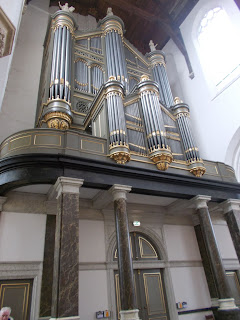




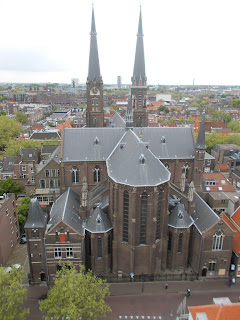





















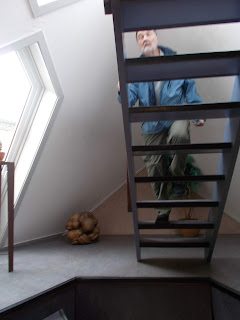

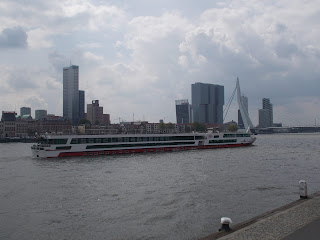







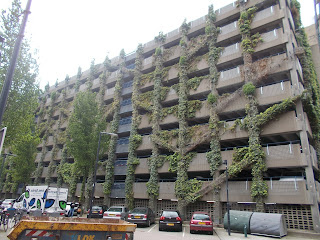













No comments:
Post a Comment